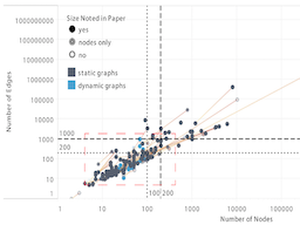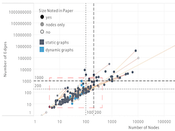Information
- Publication Type: Journal Paper (without talk)
- Workgroup(s)/Project(s):
- Date: January 2019
- DOI: https://doi.org/10.1016/j.visinf.2018.12.006
- ISSN: 2468-502X
- Journal: Visual Informatics
- Number: 4
- Open Access: yes
- Volume: 2
- Pages: 264 – 282
- Keywords: Graph visualisation, Network visualisation, node–link diagrams, Evaluations, Empirical studies, Cognitive scalability
Abstract
For decades, researchers in information visualisation and graph drawing have focused on developing techniques for the layout and display of very large and complex networks. Experiments involving human participants have also explored the readability of different styles of layout and representations for such networks. In both bodies of literature, networks are frequently referred to as being ‘large’ or ‘complex’, yet these terms are relative. From a human-centred, experiment point-of-view, what constitutes ‘large’ (for example) depends on several factors, such as data complexity, visual complexity, and the technology used. In this paper, we survey the literature on human-centred experiments to understand how, in practice, different features and characteristics of node–link diagrams affect visual complexity.Additional Files and Images
Weblinks
BibTeX
@article{YOGHOURDJIAN2019,
title = "Exploring the limits of complexity: A survey of empirical
studies ongraph visualisation",
author = "Vahan Yoghourdjian and Daniel Archambault and Stephan Diehl
and Tim Dwyer and Karsten Klein and Helen C. Purchase and
Hsiang-Yun Wu",
year = "2019",
abstract = "For decades, researchers in information visualisation and
graph drawing have focused on developing techniques for the
layout and display of very large and complex networks.
Experiments involving human participants have also explored
the readability of different styles of layout and
representations for such networks. In both bodies of
literature, networks are frequently referred to as being
‘large’ or ‘complex’, yet these terms are relative.
From a human-centred, experiment point-of-view, what
constitutes ‘large’ (for example) depends on several
factors, such as data complexity, visual complexity, and the
technology used. In this paper, we survey the literature on
human-centred experiments to understand how, in practice,
different features and characteristics of node–link
diagrams affect visual complexity.",
month = jan,
doi = "https://doi.org/10.1016/j.visinf.2018.12.006",
issn = "2468-502X",
journal = "Visual Informatics",
number = "4",
volume = "2",
pages = "264--282",
keywords = "Graph visualisation, Network visualisation, node–link
diagrams, Evaluations, Empirical studies, Cognitive
scalability",
URL = "https://www.cg.tuwien.ac.at/research/publications/2019/YOGHOURDJIAN2019/",
}


 paper
paper
